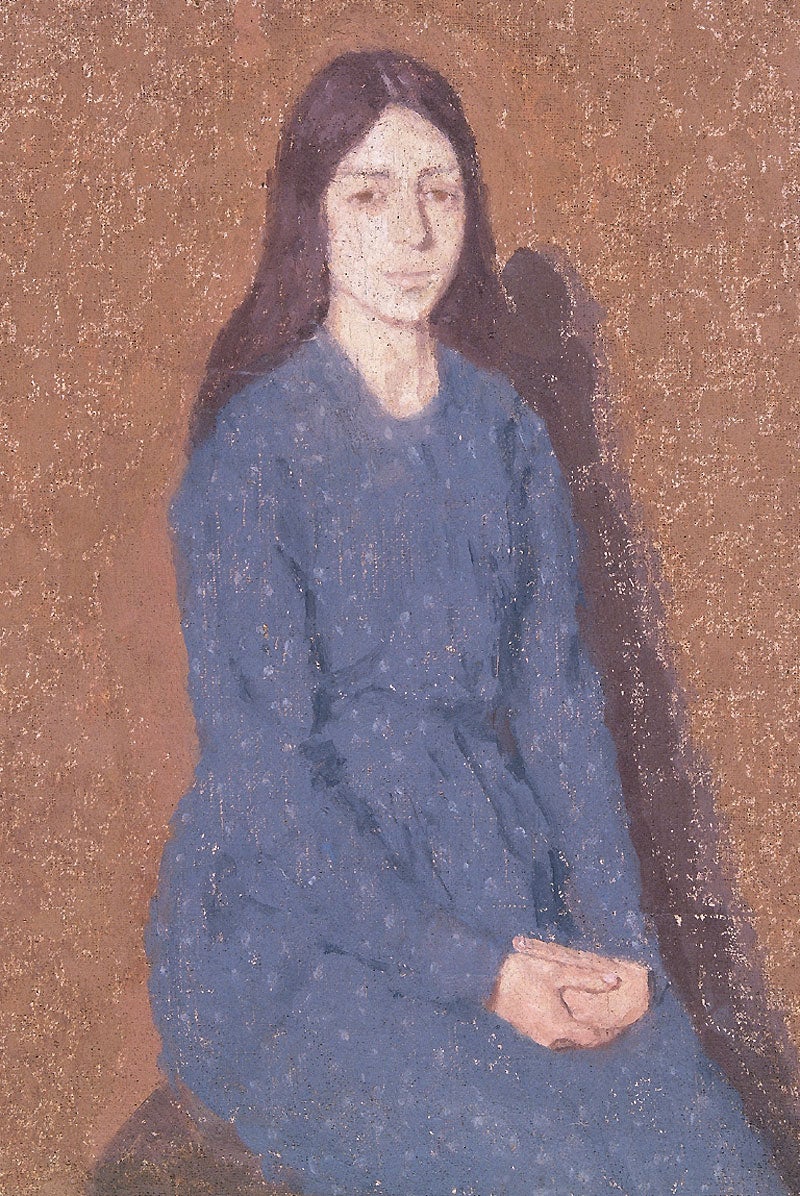John, Gwen: Girl In A Blue Dress (c.1914)
The Independent's Great Art series

There are stories about people being turned into pictures. Whether it's Keats' "Ode on a Grecian Urn" or Poe's "The Oval Portrait", the basic idea is that becoming a picture can give you immortality – at the cost of your life. In a picture you're eternally preserved from decay, but frozen in suspended animation. (Oscar Wilde's The Picture of Dorian Gray turns the idea on its head: while the living man doesn't change, his portrait ages horribly.)
These stories dwell on one aspect of being pictured: being immobilised. But they neglect another, equally important aspect: being flattened. That's understandable. We know what it feels like to be static, for short periods anyway. The experience of being flat, of withdrawing into a two-dimensional existence, is beyond us. It's very hard to evoke this side of pictorial life. Paintings can show it, though.
The women in Gwen John's paintings are often in a state of withdrawal. The Girl in a Blue Dress is one of them. She's sitting still and quiet. She looks out, but her gaze in unfocused, absorbed in reverie. Her hands are clutched tensely in her lap, arms to her sides. Her body retreats into a self-contained shape that doesn't send out any feelers into the surrounding picture.
It's a simple composition, just a figure and a background wall. She's turned to the right, but (contrary to normal portrait practice) most of the picture area is to her left, behind her, not in front of her, restricting her personal space. She's seated on some kind of stool, with her back against the wall.
Now things start to flatten. It happens in various ways. The uniform pale russet background, which is notionally a flat wall behind the woman, can easily read as the flat painted surface of the picture. And the narrow band of dark shadow she casts onto it suggests that she's right upon this surface.
The figure itself is far from being fully rounded. The darker blue strokes of shading, which edge her lighter blue dress, are abrupt and shallow, as if she wasn't a solid body but a piece of board or card. She is composed of simple areas of colour, like bits of marquetry. The soft, all-over, evenly unassertive dabs of paint, with which the whole image is composed, equate the figure and the background.
Every hue is blended with white, and the blanching of the colours makes the whole picture seem to be fading out, towards some neutral tone, some total loss of contrast, in which no feature is distinct. The expression of the woman's mouth is already barely visible. She is paling away.
You don't think of the girl as apart from the picture in which she appears. You don't think of the model as someone who temporarily sat to be painted, and went on her way. The woman is the painting. She withdraws from life, fading into its surface, pressed like a flower.
One or two elements resist the retreat into two dimensions. The clasped hands in particular stand out with a sharp solidity. But that only emphasises how far the rest of the woman has receded into flatness. She is absorbed into the picture just she is absorbed into herself. She is becoming nobody.
A show of Gwen John's work is currently showing at the Barber Institute of Fine Art, Birmingham (0121-414 7333), to 21 September
The Artist
Gwen John (1879-1939) is a reclusive, introspective, obsessional talent in the modernist mould, doing the same subject over and over, pursuing small differences, a Morandi of the solitary female figure. She lived in France. For a time she was Rodin's model and lover. She joined the Catholic Church, and painted a series of portraits of a long dead nun, currently showing at the Barber Institute .
Subscribe to Independent Premium to bookmark this article
Want to bookmark your favourite articles and stories to read or reference later? Start your Independent Premium subscription today.

Join our commenting forum
Join thought-provoking conversations, follow other Independent readers and see their replies